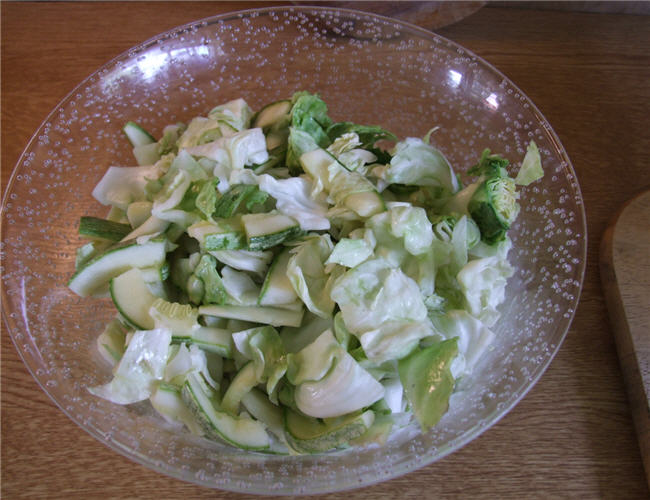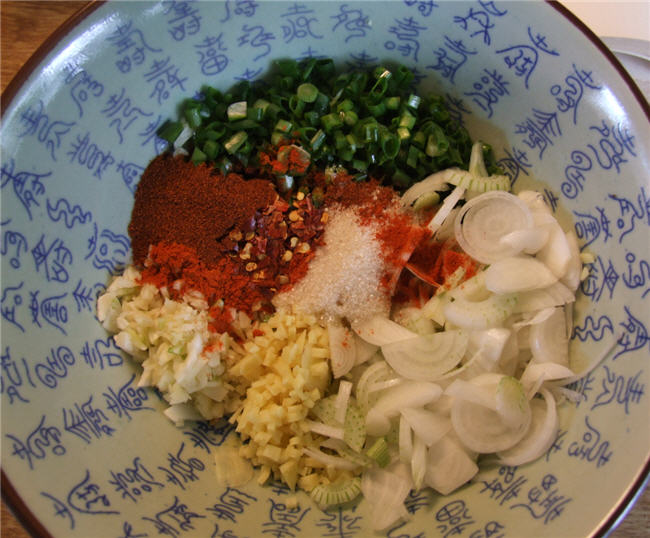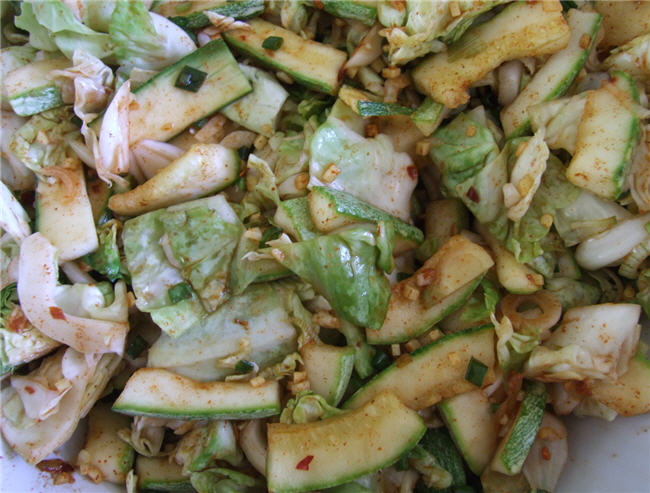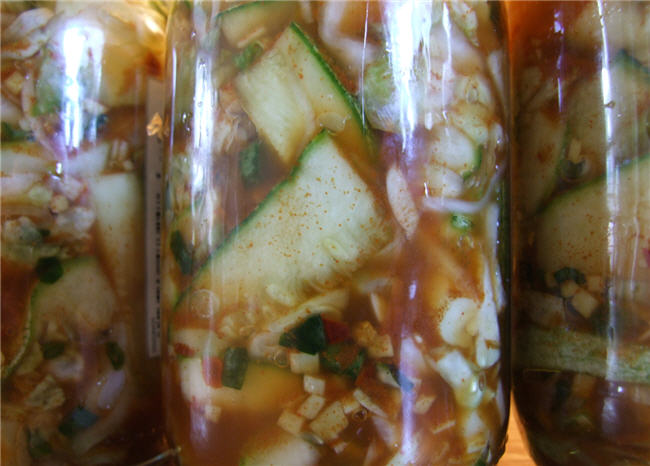Making Kimchi with cabbages and courgettes
- dealing with a glut from the garden

We've had a fine crop of cabbages and courgettes so far this summer and, as so often happens, we have a glut and have been wondering what to do with it all. Every time we go to the garden, there are more and more courgettes and the cabbages are bigger than ever. The courgette bed is getting scary.
Having gone to all the time and trouble of preparing the ground and doing the planting there was no way we wanted them to be wasted, so I started looking through my books and decided to try making kimchi.
Kimchi is the name given to a type of pickled vegetables that are made in Korea. The best known and most popular type of kimchi is made with cabbage and white radish, fermented in brine (in a process called lacto-fermentation) and flavoured with a pungent mix of chilli, spring onions and garlic. The result is sour, hot and crunchy, while the smell, which I find impossible to describe, is reminiscent of large Chinese supermarkets. You know, that weirdly attractive smell you get in those shops, that you can't identify? Kimchi.
Kimchi is delicious with rice and stir-fried vegetables and I have a notion that it would also be very good with scrambled eggs. In Korea, it is also added to soups and stews and cooked into rice, a bit like risotto. It's full of nutrients and is good for whatever ails you.
I suspect that kimchi is probably an acquired taste but, even if you're not sure whether you like it or not, something makes you want more. Months may pass, years, and you'll come across it again and immediately get a hankering to have some. The last time I'd had kimchi was about 12 years ago, but as soon as I smelled the first batch that I made, the memories came flooding back - the taste, the texture, where I'd eaten it and who with - as if it was yesterday. Strange how that happens. The funny thing was that I hadn't even realised that what I was making was something I'd had before. I'd 'cooked' it in my head while reading the recipe and thought it sounded nice.
The recipe I used is based on Madhur Jaffrey's recipe from Eastern Vegetarian Cooking. Madhur Jaffrey has been my favourite chef for nearly 30 years and I find that if she says something is good, then it is. We must have the same taste buds.
She calls for Chinese cabbage, but as we had a great deal of summer cabbage I used that instead. She also calls for white radish but we didn't have any of that either. We did, however, have a great many courgettes. I figure that you use what you've got.
Anyway, this is what I did.
Ingredients
600g summer cabbage
400g courgette
6 spring onions, finely chopped, including the green part
3 tbsp finely chopped fresh ginger
2 tbsp finely chopped garlic
3 tbsp salt
2 tbsp chilli powder
1 tbsp sugar
Method
Quarter the cabbage lengthways and remove the core. Cut into pieces about 5cm square. Cut the courgette into sections about 4cm long, halve them lengthways and then cut into slices about 4mm thick. If there is a lot of seed in the middle of the courgette, remove the core and discard it.
Add 2.5tbsp of salt to a large non-metallic bowl and add about 1.5l of water. Mix to dissolve the salt, making a brine, and then add the vegetables and mix them into the brine. Cover and leave the bowl for 12 hours, turning the vegetables occasionally.
After 12 hours, scoop the vegetables into a clean bowl, reserving the brine for later.

Drained vegetables, ready to make kimchi

The spring onion, ginger, garlic, sugar, salt and chilli
In another bowl, mix together the spring onions, ginger, garlic, chilli, sugar and the remaining salt. Madhur Jaffrey calls for cayenne or Korean red pepper, but we had neither of those. What we did have were some chilli flakes, paprika and some chilli powder from Kenya, which is so hot that I'd put a label on it, renaming it 'Bio-hazard'. When you open the jar, people on the other side of the room start sneezing. So if you're thinking that the amount of chilli looks a bit paltry, that's why.
Add all this to the bowl of cabbage and courgette and mix it well, then stand back and admire it.

Spices mixed into the kimchi
Take some clean glass jars and pack the mix into them, squashing it down. Spoon in any juices left in the bottom of the bowl and then top the jars up with the brine that you set aside earlier.

Freshly jarred kimchi
Set the jars to one side. Leave the lids off but cover them with a clean tea towel. The next stage, the fermenting, takes from three to seven days, depending on the temperature. The mix should start to bubble a bit. After three days, test some for flavour and sourness. If you like it, then lid the jars and keep them in the fridge. If not, leave them a few more days and try it again. I lidded ours after six days. I'd kept the jars sitting on a tray under a table in the hallway.
As the kimchi continues to ferment, it will become more sour/acid and the vegetables will soften. If you haven't tried it before, take it easy to start with as some people are more comfortable with sour foods than others. How you like it really depends on you - some like it very sour and others don't. It's personal. If it has become too sour for your taste, then it can be added to fried rice or soups and stews.
Enjoy!

© Copyright Miranda Hodgson 2009